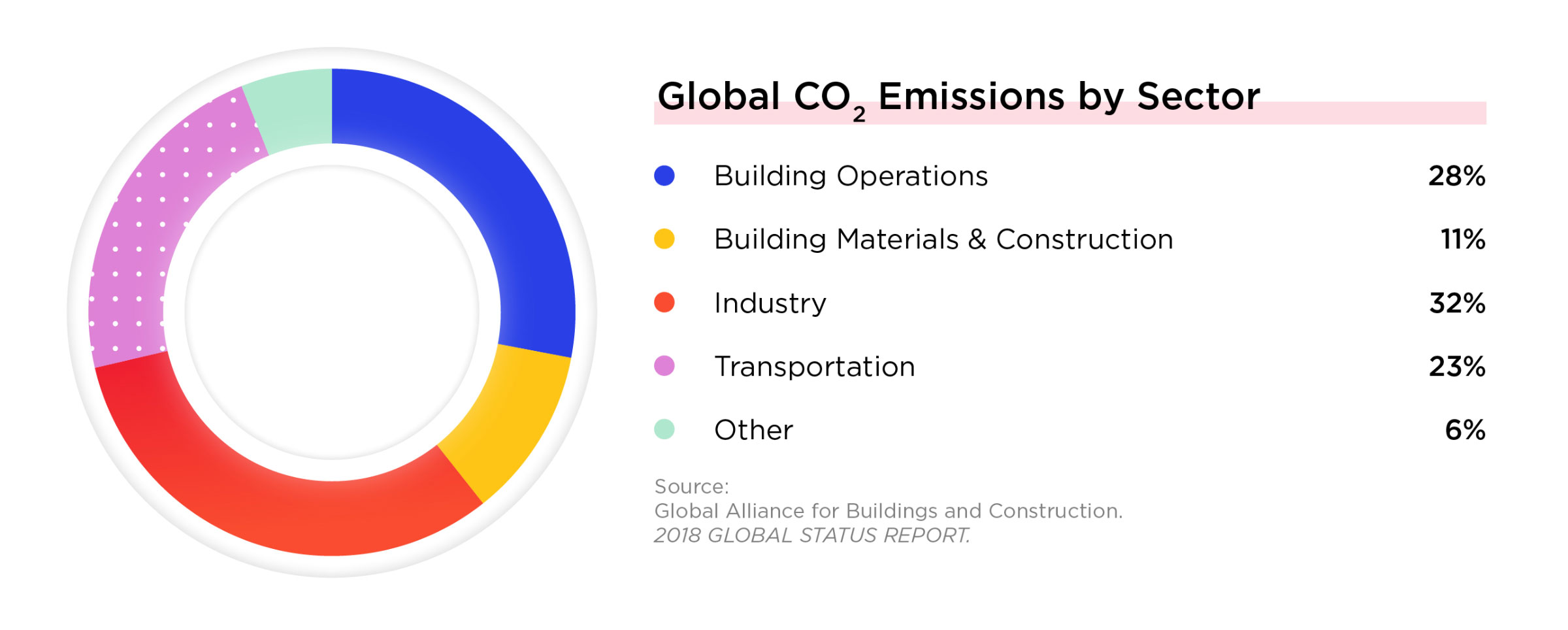Architects and designers are increasingly focused on sustainability—it is one of the most important and exciting design challenges of our time.
According to Lance Hosey, FAIA, LEED Fellow and design resilience director for Gensler, studies show that designers and architects can impact up to 90% of a project’s eventual impact based on the earliest design decisions.
For too long we have held on to outdated notions that green building standards and sustainable materials are too expensive, it is too time consuming to do the research, it is too difficult to get the certifications, the materials are not creative enough, not flexible or durable enough, and that our clients aren’t concerned about it.
The reality is that advances in technology and focus on sustainable design have helped address each one of these issues. Demand from clients to deliver more sustainable projects is increasing, and the green building and design sector is growing.
When selecting materials architects and interior designers (and consumers) are usually more aware of aesthetic and cost considerations than what a material contains or where it comes from. But green building standards and the design market are changing, and sustainable materials are gaining importance. The popularity of sustainable materials has grown in the last decade. Architects and designers are realizing that sustainable design doesn’t mean limited design.
Buildings generate nearly 40% of annual global greenhouse gas emissions, so green building and design represents a critical part of the solution to help mitigate emissions, stemming the negative impacts of climate change.

Courtesy of Aquafil
According to Zero Code, a new building energy standard focused on the establishment of zero carbon buildings, we are currently undergoing the largest wave of urban growth in human history: by 2060, we will double our current global building stock. Only by eliminating CO2 emissions from new building operations will we begin to reduce building sector emissions.
Using sustainable materials on architecture and design projects offers several environmental benefits: reduced energy use, lower greenhouse gas emissions, protection of natural resources, water-use reduction, improvement of air quality, and waste reduction.
So, how do we get started?
Set the Vision and Goals
First, set measurable green building targets and commit to achieving them as an organization. This type of mindset shift does not happen overnight and it must be a whole group effort. Decide what pace of progress your firm wants to commit to, and then go after it.
The United Nations Global Compact provides solid guidance on setting strategic sustainability goals:
- Focus on issues that are strategically important to your company.
- Set stretch goals.
- Connect your goals to your business strategy.
- Ensure support and ownership.
For example, HKS Architects has set a bold goal and joined the American Institute of Architects 2030 commitment to make all new buildings, developments and major renovations carbon-neutral by 2030, while Perkins + Will has evolved its sustainability goals over time. From scaling back business air travel, to achieving a minimum of LEED Gold certification for all of its design studios, reducing the use of paper products, and investing in Green-e Certified Renewable Energy Credits (RECs) and carbon offsets, Perkins + Will achieved firm-wide carbon neutrality in 2007.
Evolve Your Processes
Another important step in committing to green building standards is to create new processes for the way you select materials.
The US Environmental Protection Agency (EPA) reports that global consumption of materials increased rapidly during the last century. Global raw material use rose during the 20th century at about twice the rate of population growth, according to the Annex to the G7 Leaders’ June 8, 2015 Declaration.
When evaluating materials, interior designers and architects should adopt a lifecycle perspective that considers all of the environmental impacts generated by every phase of the production, use, and disposal of materials. This allows us to take into account both direct impacts—such as quality and quantity of energy consumption, process efficiencies, and emissions—and indirect impact for producing raw materials.

Courtesy of Aquafil
By looking at the entire life cycle of a product—from materials extraction to end-of-life management—we can continuously find opportunities to reduce its environmental impact, conserve resources, and reduce costs. We should seek ways to redesign products so they are manufactured using fewer, less toxic and more durable materials. Products and materials should also be designed so that at the end of its useful life it can be readily disassembled to upcycling and reuse.
For example, ECONYL® regenerated nylon is made from 100% waste instead of oil and offers up to 90% reduction in global warming potential compared to nylon from fossil sources.
Leverage Innovative, Credible Resources
There are many new and innovative resources to help us source more sustainable materials for architecture and design projects. Two resources at the top of our list are mindful Materials and Material Bank.
mindful Materials
mindful Materials was started by HKS Architects in 2014 as a free platform that has become the leading building industry resource for aggregated health and sustainability product data. The platform now stands on its own featuring more than 8,200 sustainable products and more than 6,500 users.
For sustainable projects, building project teams require innovative, trusted resources to identify and specify products that comply with varying forms of disclosure and optimization.
The mindful MATERIALS Library is a practical product selection tool for design teams needing to incorporate product transparency information into their real-time project decisions. The products included in the library are carefully vetted by industry working groups so you can trust the information and avoid using products that are known for greenwashing.
Architectural building products with various transparency and sustainability attributes are categorized by:
- Material ingredients
- Environmental profile
- VOCs
- Material sourcing
- Social responsibility
- Other transparency information
Material Bank
Material Bank is the world’s largest material marketplace for the architecture and design industry. It is the most innovative way to search, sample, and design projects.
Designers can specify more sustainable textiles for their projects by easily searching by application, color, construction, pattern, and environmental benefits and standards. Samples ordered by midnight Eastern Standard Time are delivered the next day at no cost. Material Bank offsets 100% of direct carbon emissions from all sample shipments, and samples can be easily returned to Material Bank for reuse, which eliminates waste.
Designers can also use Material Bank’s innovative, custom design boards and palettes customized for their projects that have the ability to invite collaborators to contribute and are also shareable with teams and clients.
If you haven’t started your sustainability journey yet, it’s never too late to start. It will require time and effort, but there are so many great resources available to support your organization’s evolution that it’s easier than ever before to start and sustain progress.
We all have an important role to play in ensuring a safe, healthy environment for future generations. Change starts with us. The time to embed green building standards and sustainable practices into your organization is now.





